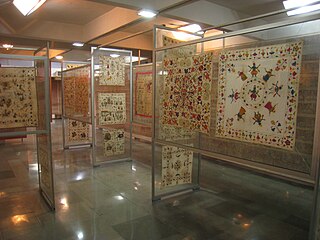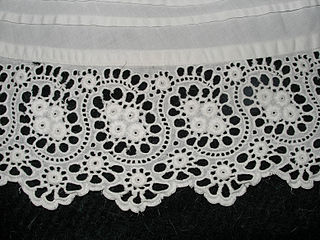
Embroidery is the art of decorating fabric or other materials using a needle to apply thread or yarn. Embroidery may also incorporate other materials such as pearls, beads, quills, and sequins. In modern days, embroidery is usually seen on caps, hats, coats, overlays, blankets, dress shirts, denim, dresses, stockings, scarfs, and golf shirts. Embroidery is available in a wide variety of thread or yarn colour. It is often used to personalize gifts or clothing items.

Berlin wool work is a style of embroidery similar to today's needlepoint that was particularly popular in Europe and America from 1804 to 1875. It is typically executed with wool yarn on canvas, worked in a single stitch such as cross stitch or tent stitch, although Beeton's book of Needlework (1870) describes 15 different stitches for use in Berlin work. It was traditionally stitched in many colours and hues, producing intricate three-dimensional looks by careful shading. Silk or beads were frequently used as highlights. The design of such embroidery was made possible by the great progress made in dyeing, initially with new mordants and chemical dyes, followed in 1856, especially by the discovery of aniline dyes, which produced bright colors.

Counted-thread embroidery is any embroidery in which the number of warp and weft yarns in a fabric are methodically counted out for each stitch, resulting in uniform-length stitches and a precise, uniform embroidery pattern. Even-weave fabric is usually used, producing a symmetrical image, as both warp and weft yarns are evenly spaced.

A quilt is a multi-layered textile, traditionally composed of two or more layers of fabric or fiber. Commonly three layers are used with a filler material. These layers traditionally include a woven cloth top, a layer of batting or wadding, and a woven back combined using the techniques of quilting. This is the process of sewing on the face of the fabric, and not just the edges, to combine the three layers together to reinforce the material. Stitching patterns can be a decorative element. A single piece of fabric can be used for the top of a quilt, but in many cases the top is created from smaller fabric pieces joined, or patchwork. The pattern and color of these pieces creates the design.

Sashiko is a type of traditional Japanese embroidery or stitching used for the decorative and/or functional reinforcement of cloth and clothing. Owing to the relatively cheap nature of white cotton thread and the abundant nature of cheap, indigo-dyed blue cloth in historical Japan, sashiko has a distinctive appearance of white-on-blue embroidery, though some decorative pieces may also use red thread.

Crewel embroidery, or crewelwork, is a type of surface embroidery using wool. A wide variety of different embroidery stitches are used to follow a design outline applied to the fabric. The technique is at least a thousand years old.
Needlepoint is a type of canvas work, a form of embroidery in which yarn is stitched through a stiff open weave canvas. Traditionally needlepoint designs completely cover the canvas. Although needlepoint may be worked in a variety of stitches, many needlepoint designs use only a simple tent stitch and rely upon color changes in the yarn to construct the pattern. Needlepoint is the oldest form of canvas work.

Darning is a sewing technique for repairing holes or worn areas in fabric or knitting using needle and thread alone. It is often done by hand, but using a sewing machine is also possible. Hand darning employs the darning stitch, a simple running stitch in which the thread is "woven" in rows along the grain of the fabric, with the stitcher reversing direction at the end of each row, and then filling in the framework thus created, as if weaving. Darning is a traditional method for repairing fabric damage or holes that do not run along a seam, and where patching is impractical or would create discomfort for the wearer, such as on the heel of a sock.
Filet lace is the general word used for all the different techniques of embroidery on knotted net. It is a hand made needlework created by weaving or embroidery using a long blunt needle and a thread on a ground of knotted net lace or filet work made of square or diagonal meshes of the same sizes or of different sizes. Lacis uses the same technique but is made on a ground of leno or small canvas.

Reticella is a needle lace dating from the 15th century and remaining popular into the first quarter of the 17th century.

Embroidery in India includes dozens of embroidery styles that vary by region and clothing styles. Designs in Indian embroidery are formed on the basis of the texture and the design of the fabric and the stitch. The dot and the alternate dot, the circle, the square, the triangle, and permutations and combinations of these constitute the design.

Cutwork or cut work, also known as punto tagliato in Italian, is a needlework technique in which portions of a textile, typically cotton or linen, are cut away and the resulting "hole" is reinforced and filled with embroidery or needle lace.

Cross stitches in embroidery, needlepoint, and other forms of needlework include a number of related stitches in which the thread is sewn in an x or + shape. Cross stitch has been called "probably the most widely used stitch of all" and is part of the needlework traditions of the Balkans, Middle East, Afghanistan, Colonial America and Victorian England.

Ideas from mathematics have been used as inspiration for fiber arts including quilt making, knitting, cross-stitch, crochet, embroidery and weaving. A wide range of mathematical concepts have been used as inspiration including topology, graph theory, number theory and algebra. Some techniques such as counted-thread embroidery are naturally geometrical; other kinds of textile provide a ready means for the colorful physical expression of mathematical concepts.

English embroidery includes embroidery worked in England or by English people abroad from Anglo-Saxon times to the present day. The oldest surviving English embroideries include items from the early 10th century preserved in Durham Cathedral and the 11th century Bayeux Tapestry, if it was worked in England. The professional workshops of Medieval England created rich embroidery in metal thread and silk for ecclesiastical and secular uses. This style was called Opus Anglicanum or "English work", and was famous throughout Europe.

The term Provençal quilting, also known as boutis, refers to the wholecloth quilts done using a stuffing technique traditionally made in the South of France from the 17th century onwards. Boutis is a Provençal word meaning 'stuffing', describing how two layers of fabric are quilted together with stuffing sandwiched between sections of the design, creating a raised effect. The three main forms of the Provençal quilt are matelassage, piqûre de Marseilles, and boutis. These terms, along with trapunto are often debated and confused, but they are all forms of stuffed quilting associated with the region.
Maria E. Piñeres is a Colombia-born American artist who lives and works in Los Angeles, CA. Her work, mostly embroidery, has been exhibited at the Museum of Art & Design in New York City. and Scottsdale Museum of Contemporary Art. She studied painting at The Art Students League of New York and graduated from Parsons School of Design with a BFA in illustration.

Embroidery was an important art in the Islamic world from the beginning of Islam until the Industrial Revolution disrupted traditional ways of life.
The Sujani embroidery work of Bihar, is a textile expressive art product, given protection under the GI registration act. It is usually a quilt or bed spread, which was earlier made of old clothes, but is now generally made of easily available fabric with embroidery done with the most simple stitches with motifs narrating stories. It is exclusively made by women in 15 villages of Bhusra in the Gaighat block of Muzaffarpur and a few villages of Madhubani in the Indian state of Bihar.

Colcha embroidery from the southwest United States is a form of surface embroidery that uses wool threads on cotton or linen fabric. During the Spanish Colonial period, the word colcha referred to a densely embroidered wool coverlet. In time, the word also came to refer to the embroidery stitch that was used for these coverlets, and then began to be used on other surfaces. The colcha stitch is self-couched, with threads applied at a 45-degree angle to tie down the stitch. Originally, the wool threads were dyed naturally, using plants or insects, such as cochineal. Both materials used and design motifs have varied over time.






















